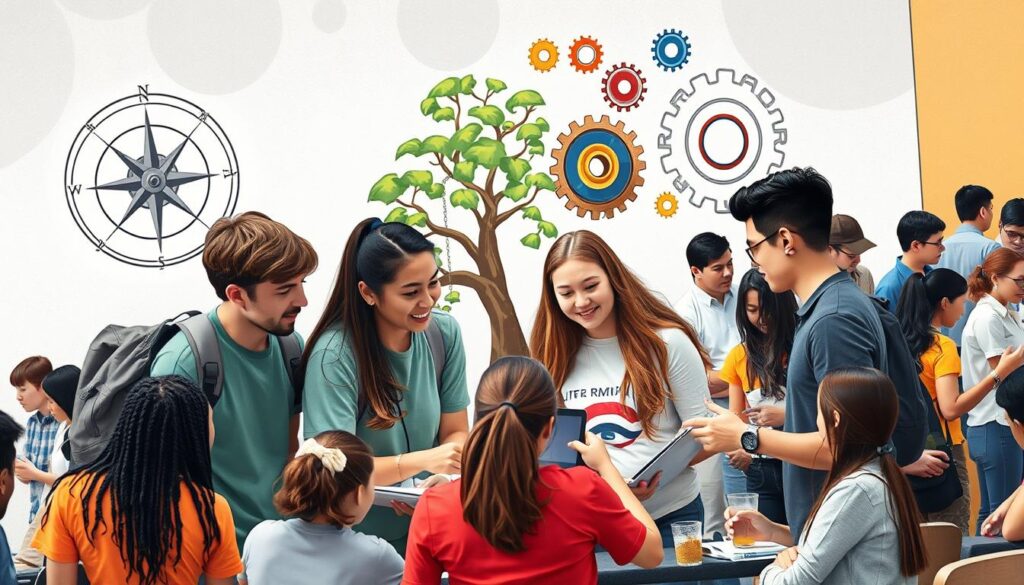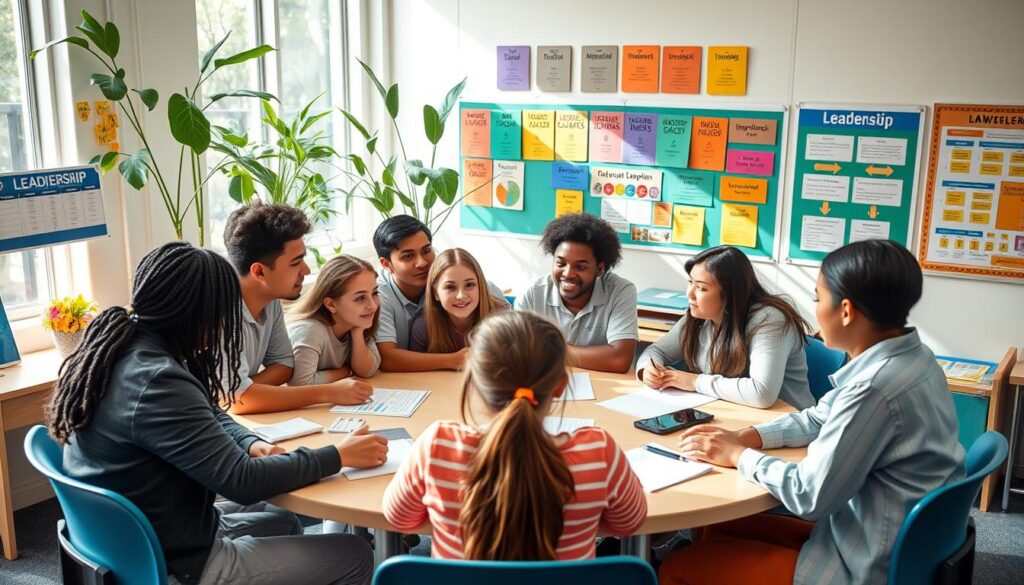Did you know that only about 10% of high schools mix academic theory with practical application in their leadership programs? This shows a big need for better leadership training for students today. With the world changing fast, young adults need skills for school, social life, and future jobs. Programs focused on youth leadership help students grow and succeed in different settings.
Through student leadership programs, students can face tough situations with more confidence and skill. These programs teach a proactive mindset, showing the value of ongoing personal growth. By building leadership skills in young adults, we help them reach their full potential.
Key Takeaways
- Only a small percentage of high schools effectively combine academic theory and practical application in leadership programs.
- Different leadership positions require a variety of core skills, including organizational and public speaking skills.
- Experiential learning models are essential to provide students with opportunities to learn, reflect, and act.
- Engagement in leadership programs leads to increased motivation and better understanding of leadership concepts.
- Interactive activities can enhance critical thinking, problem-solving, and communication abilities among students.
Understanding Leadership Development for Students
Leadership development is key for students’ futures. It helps them grow personally and sets them up for success in their careers. Students learn to take responsibility, communicate better, and work together when they learn to lead.
These skills are crucial as they move to college and start their careers. They become essential for their professional growth.
The Importance of Leadership Skills for Young Adults
Being a good leader can boost your career. Learning to lead is a basic part of growing in your career. It’s not just about being born with the right traits.
Skills like managing conflicts, motivating teams, and delegating tasks are vital. Leadership training helps students develop these skills. Good communication, like listening and speaking clearly, is also key to being a leader.
Students should look for chances to lead, like being a club officer or working on community projects. These experiences help them improve their leadership abilities.
Differentiate Between Leadership Education and Training
Leadership education and training have different roles in shaping future leaders. Education provides a theoretical base, covering leadership principles and history. Training, on the other hand, focuses on practical skills, making it important for students to apply what they learn in real situations.
Combining both education and training helps students grow as leaders. By participating in workshops and events, they can understand leadership theories better and apply them in practice.

| Leadership Skills for Young Adults | Leadership Education | Leadership Training for Students |
|---|---|---|
| Essential for effective career development | Theoretical framework on principles and history | Focus on practical applications in real-world settings |
| Involves managing conflicts and motivating teams | Understanding different leadership styles and theories | Opportunities for hands-on experience via workshops |
| Facilitates communication and collaboration | Promotes critical thinking and decision-making skills | Encourages goal-setting and progress tracking |
| Accessible to all willing to learn | Blends theory with ongoing reflections | Involves mentorship and support from experienced leaders |
Core Leadership Skills Every Student Should Develop
Every student needs to develop key leadership skills for the future. These skills help them grow into effective leaders. They do well in school and in other areas of life.
Communication and Public Speaking Skills
Good communication skills are the base of leadership. They help people share their thoughts clearly. This is important for talking with others, whether it’s in school or in the community.
Public speaking can be scary for some. But learning to speak up confidently is key. It makes sharing ideas and working together easier.
Decision-making and Problem-solving Abilities
Being able to make decisions and solve problems is important for leaders. These skills help students tackle challenges and find solutions. This is useful in school and in the workplace.
Studies show that leaders who practice these skills grow personally and academically. Students learn by taking on real challenges and leading projects.
Time Management and Goal Setting
Managing time and setting goals are key for teens. These skills help students focus and achieve more. They also help students adapt and stay strong.
Being in leadership roles helps students improve these skills. It builds their confidence and prepares them for the future.

| Skill | Importance | Benefits for Students |
|---|---|---|
| Communication Skills | Essential for sharing ideas and fostering teamwork | Boosts confidence and enhances interpersonal relationships |
| Decision-making | Crucial for effective problem-solving | Prepares students for real-world challenges |
| Time Management | Helps in prioritizing tasks and maximizing productivity | Enhances academic performance and personal growth |
The Role of Student Leadership Programs
Student leadership programs are key in helping young adults grow. They offer many ways to learn and develop leadership skills. Students can join student government, workshops, or mentorship programs. These activities match their interests and goals.
Types of Programs Available
There are many leadership programs for college students. Each focuses on different leadership skills:
- Student Government: Offers a chance to practice governance and decision-making.
- Mentorship Programs: Connects students with experienced leaders for guidance.
- Workshops and Seminars: Teaches skills like public speaking and project management.
- Community Service Initiatives: Helps students develop teamwork and social responsibility.
Benefits of Participating in Leadership Programs
Being part of student leadership programs has many advantages. Students gain:
- Enhanced Communication Skills: They learn to speak in public and communicate ideas well.
- Developing Strong Leadership Qualities: They learn to make decisions and solve problems.
- Building a Robust Network: They meet peers, mentors, and professionals, opening doors to careers.
- Boosting Self-Confidence: Leadership roles boost self-esteem through recognition.
- Gaining Real-World Experience: They get hands-on experience through projects and internships.
Creating Effective Student Leadership Development Opportunities
Starting impactful student leadership programs begins with finding what’s already available in schools. It’s important to list all activities, like sports, clubs, and community service. Seeing how groups like the Student Leadership Coalition (SLC) help students grow is key. Schools can then use these to create great leadership programs for high school students.
Identifying Existing Programs and Opportunities
The first step is to understand what is presently available in schools. The SLC, for example, started small but grew a lot. It shows how important it is to have a supportive environment. Schools can find more chances for students to lead by regularly checking what’s available.
- Student-run meetings that encourage participation
- Events promoting teamwork through community service
- Fundraising initiatives that foster responsibility and planning
Augmenting Current Curricular and Extracurricular Activities
To make student leadership programs better, schools should add educational parts to activities. Turning some activities into leadership roles can really help students. For example, they can plan events or help with fundraising. This way, they learn important skills.
By making sure everyone can participate, schools build a positive community. Students who get involved often feel more motivated and responsible. This helps them do their best.
| Program Elements | Description | Benefits |
|---|---|---|
| Inclusivity Practices | Encouraging diverse representation and voices | Fosters a sense of belonging among all participants |
| Service Learning Projects | Hands-on community engagement projects | Enhances practical application of leadership skills |
| Student Leadership Roles | Positions like president, vice president, etc. | Builds accountability and experience in governance |
| Event Organization | Students plan and manage school events | Develops teamwork, planning, and execution skills |
| Feedback Mechanisms | Formal processes for receiving student input | Improves programs based on participant insights |
By focusing on improving leadership activities, students have amazing experiences. These experiences prepare them for the future and help their communities.
Implementing Experiential Learning Models
Experiential learning models are key in teaching leadership skills to teens. This method involves learning by doing, reflecting, and then acting. It helps students link what they learn in class to real-life situations.
By taking part in different experiences, students gain a deeper understanding of leadership. They learn and remember important skills better.
The Cycle of Learning, Doing, Reflecting, and Acting
The cycle of experiential learning has four stages: experience, reflect, generalize, and apply. I find that getting involved in real-world leadership projects helps me grow. It pushes me out of my comfort zone.
At each stage, I think about what I’ve learned, apply those lessons, and use them in new situations. This way, I develop both hard and soft skills, which are vital for leadership.
Importance of Real-world Applications in Leadership
Real-world applications are essential for learning leadership skills. I’ve seen that experiential learning makes learning faster and more effective. It helps me remember and use what I’ve learned better.
Activities like outdoor education and team-building exercises help me grow personally and work better with others. These experiences build my confidence and prepare me to tackle challenges.
| Stage | Description | Benefits |
|---|---|---|
| Experience | Engage in hands-on activities. | Enhances engagement and commitment. |
| Reflect | Consider the experience and outcomes. | Encourages critical thinking and self-awareness. |
| Generalize | Draw connections to broader concepts. | Facilitates application of lessons learned. |
| Apply | Implement new skills in different contexts. | Strengthens retention and adaptability. |
Strategies to Engage Students in Leadership Training
Innovative strategies are key to keeping students engaged in leadership training. Interactive activities for youth make learning fun and hands-on. This way, students dive deep into leadership principles. Group talks, role-playing, and simulations boost critical thinking and teamwork.
Interactive and Collaborative Activities
Interactive activities draw students into the learning process. They spark participation and interest. Here are some top activities:
- Group discussions that foster communication and collaboration among peers.
- Service learning projects that connect students with community needs while developing leadership skills.
- Team-building exercises, such as escape rooms or obstacle courses, that emphasize cooperation and trust.
- Organizing school campaigns or fundraisers to create real-world leadership experiences.
These activities help students develop leadership skills. They also build confidence and improve problem-solving in different situations.
Utilizing Technology for Enhanced Engagement
Technology has changed how we teach leadership. Learning becomes more dynamic and collaborative with the use of digital technologies:
| Technology Tool | Benefits |
|---|---|
| Online Collaborative Platforms | Encourages group projects and discussions from remote locations. |
| Multimedia Resources | Engages students through videos, podcasts, and interactive presentations. |
| Social Media for Communication | Helps students practice leadership in a digital space, broadening their reach. |
Students gain leadership skills in the modern world by using these resources. It makes the training both relevant and effective.
Empowering Student Leaders through Mentorship
Helping student leaders grow through mentorship is key. It lets them learn from each other in a supportive group. This way, they can improve their leadership skills and share different views, making their community stronger.
Peer-to-Peer Learning Opportunities
Learning from each other is a big plus in student leadership. They can discuss issues, exchange solutions, and form friendships in workshops. They learn important things like:
- Effective communication
- Collaboration and teamwork
- Critical thinking and problem-solving
They benefit from these abilities both now and in the future. Schools that welcome everyone make these learning chances even better.
The Role of Experienced Leaders in Mentorship Programs
Experienced leaders are vital in guiding new student leaders. They offer advice, encouragement, and feedback. This helps a lot in their leadership journey. Schools with strong mentorship programs see:
- More students getting involved in leadership
- A more diverse leadership team
- Students feeling more confident
These places create a community where everyone feels valued. They help students grow into leaders who can really make a difference.
| Aspect | Peer-to-Peer Mentorship | Experienced Leader Mentorship |
|---|---|---|
| Focus | Collaborative learning | Guidance and support |
| Beneficiaries | Fellow students | Aspiring leaders |
| Skills Developed | Communication, teamwork | Confidence, decision-making |
| Impact on Community | Building supportive networks | Cultivating leadership culture |
Measuring the Success of Leadership Initiatives
Assessing the effectiveness of leadership programs is crucial. We do this by getting feedback from those who take the programs. This helps teachers see what’s working and what needs work.
By looking at how students do in leadership, we learn a lot. We see how well they’re doing and how good the programs are.
Importance of Feedback and Continuous Improvement
Getting better starts with getting criticism. It helps us see if people are getting better at things like talking and making decisions. A big IT company saw less people leaving after they improved their leadership training.
This shows how important it is to make choices based on what people say and how well things are working.
Tracking Participation and Performance Metrics
To really know if things are working, we need to track a few things. We look at how many people are involved, how they use online tools, and how many leaders we reach. Then, we study this data to learn more.
A big drug company saw their sales go up a lot after they trained their sales team. This shows how training leaders can help a company grow.
Using the Kirkpatrick Model helps us check how well training is working. It looks at four levels: how people react, what they learn, how they act, and the results. Each level helps us understand how people and companies are growing.
In the end, a good plan for leadership development makes sure programs meet student needs. It helps them grow personally and professionally.
Common Challenges in Leadership Development for Students
In the world of student leadership, I see big hurdles that slow progress. One big issue is getting students to join in. Many feel they can’t lead, so they don’t participate. This feeling is made worse by imposter syndrome, which makes them doubt themselves even when they succeed.
Society also plays a part by limiting what students think leadership is. This makes them stick to certain ideas of leadership, not exploring others. This can hold them back from finding their own leadership style.
Addressing Barriers to Student Engagement
To beat these barriers, we need to create a welcoming space. Teachers should make sure all students feel they can show their talents. Studies show that students in leadership programs feel more connected and engaged in school.
By tackling the emotional and mental hurdles, we can get more students to take on leadership roles. This is key to their growth and success.
Overcoming Stereotypes About Leadership Styles
It’s also vital to break down old ideas about leadership. For too long, we’ve seen leadership as only for the outgoing. But real leadership is about being open, admitting mistakes, and listening to others.
By showing that leadership comes in many forms, we help students find their true potential. This way, we create a fair and diverse future for leaders.
FAQ
What is the importance of leadership development for students?
Leadership development is key for students. It gives them the skills needed for school, social life, and future jobs. It helps them tackle today’s global challenges.
What types of student leadership programs are available?
There are many programs for students. These include student government, peer mentorship, workshops, and conferences. They all aim to improve teamwork, communication, and motivation.
How can students develop leadership skills?
Students can grow their leadership skills in many ways. They can join workshops, participate in hands-on learning, and get involved in leadership programs. Focus areas include speaking clearly, making decisions, and managing time well.
What is the difference between leadership education and training?
Leadership education covers the theory of leadership. It looks at the history and principles. On the other hand, training focuses on how to apply these ideas in real life. Combining both helps students prepare for the future.
Why are mentorship programs vital for student leaders?
Mentorship programs offer learning from peers and experienced leaders. They provide guidance and feedback. This builds a strong leadership culture and helps students on their leadership path.
How should schools create effective leadership development opportunities?
Schools should look at what programs they already have. They should add structured education and training. Also, improving school activities can give students valuable leadership experiences.
What challenges do students face in leadership development?
Students often face barriers to getting involved and stereotypes about leadership. Some might feel scared or unsure. Societal norms can also limit their view of leadership.
How can technology be utilized in leadership training for students?
Technology can make learning more engaging. It uses online platforms and multimedia. This lets students practice leadership in today’s world and participate actively.
What role do real-world applications play in youth leadership training?
Real-world applications, like simulations and community projects, give students practical skills. They learn by doing. This makes leadership concepts more meaningful.
How can the success of leadership initiatives be measured?
Success can be tracked through feedback, participation, and performance metrics. This helps improve programs. It ensures they meet student needs and keep getting better.



